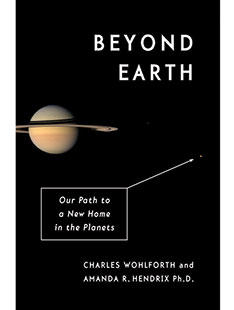
What is the next frontier for humankind? If you guessed the moon or Mars, Charles Wohlforth ’86 invites you to think again. In Beyond Earth (Pantheon), Wohlforth and planetary scientist Amanda R. Hendrix make a case for Titan, Saturn’s largest moon, as the likeliest location for human colonization.
Don’t confuse Beyond Earth with a sci-fi novel. The book’s predictions about the future are grounded in reality and take into account “dumb decisions, selfish drives, and messy politics,” the authors write.
A book about space might seem like a departure for Wohlforth, a lifelong Alaskan whose work is mostly tied to his home state and its great outdoors. He has produced travel guides, covered the Exxon Valdez oil spill, and penned 10 books, including The Whale and the Supercomputer: On the Northern Front of Climate Change (North Point Press). He has also worked for education equity in rural Alaska and served on Anchorage’s city council.
Look closely at Beyond Earth, though, and it’s easy to notice themes from Wohlforth’s prior work. Catastrophic consequences of climate change are among the hypothetical scenarios that impel humans to seek refuge in space. Parallels to Alaska appear in passages about spurring development on an untamed frontier.
Why Titan? Its nitrogen atmosphere is roughly the right pressure for human life, the authors say. The atmosphere also would protect humans from radiation, unlike Mars or the moon. A supply of cheap energy and construction materials abounds on Titan in the form of hydrocarbons like methane. NASA’s Cassini probe has been delivering information on Titan for years.
Yet Titan is no utopia. Its frigid climate is the least of its obstacles. The book discusses mental and physical health barriers to deep space, such as weakness due to long-term weightlessness.
Bureaucratic obstacles abound, too. Caution has been NASA’s watchword since the 1986 Challenger disaster, to the detriment of inspiring the public, Wohlforth argues. NASA needs a new moonshot, he says in an interview, “and putting people in space would be a long-term goal that has meaning.” The agency’s budget is at the mercy of political institutions, but Wohlforth says that NASA could make progress by leaving rocket-building to private industry, invoking competition to build vessels faster and at lower cost.
Wohlforth and Hendrix make a good-faith attempt to prognosticate by taking a practical look at emerging technology. They also segregate speculation into clearly labeled sections to distinguish it from facts. “We wanted to give readers evidence, and then let a scenario play out without making a lot of firm predictions,” Wohlforth says.
“If in 20 years people want to go back and find fault with our predictions,” he jokes, “there will be plenty to find.”
The book concludes with the idea that both space exploration and environmentalism represent higher human callings. In that way, Beyond Earth is less a book about space and more of a circuitous argument for why Earth is irreplaceable.












No responses yet